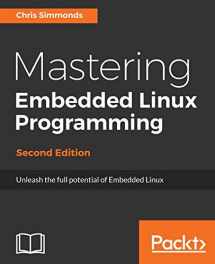
Mastering Embedded Linux Programming - Second Edition: Unleash the full potential of Embedded Linux with Linux 4.9 and Yocto Project 2.2 (Morty) Updates
Book details
Summary
Description
Key Features
- Discover how to build and configure reliable embedded Linux devices
- This book has been updated to include Linux 4.9 and Yocto Project 2.2 (Morty)
- This comprehensive guide covers the remote update of devices in the field and power management
Embedded Linux runs many of the devices we use every day, from smart TVs to WiFi routers, test equipment to industrial controllers - all of them have Linux at their heart. Linux is a core technology in the implementation of the inter-connected world of the Internet of Things.
The comprehensive guide shows you the technologies and techniques required to build Linux into embedded systems. You will begin by learning about the fundamental elements that underpin all embedded Linux projects: the toolchain, the bootloader, the kernel, and the root filesystem. You'll see how to create each of these elements from scratch, and how to automate the process using Buildroot and the Yocto Project.
Moving on, you'll find out how to implement an effective storage strategy for flash memory chips, and how to install updates to the device remotely once it is deployed. You'll also get to know the key aspects of writing code for embedded Linux, such as how to access hardware from applications, the implications of writing multi-threaded code, and techniques to manage memory in an efficient way. The final chapters show you how to debug your code, both in applications and in the Linux kernel, and how to profile the system so that you can look out for performance bottlenecks.
By the end of the book, you will have a complete overview of the steps required to create a successful embedded Linux system.
What you will learn- Evaluate the Board Support Packages offered by most manufacturers of a system on chip or embedded module
- Use Buildroot and the Yocto Project to create embedded Linux systems quickly and efficiently
- Update IoT devices in the field without compromising security
- Reduce the power budget of devices to make batteries last longer
- Interact with the hardware without having to write kernel device drivers
- Debug devices remotely using GDB, and see how to measure the performance of the systems using powerful tools such as perk, ftrace, and valgrind
- Find out how to configure Linux as a real-time operating system
- Starting Out
- Learning About Toolchains
- All About Bootloaders
- Configuring and Building the Kernel
- Building a Root Filesystem
- Selecting a Build System
- Creating a Storage Strategy
- Updating Software in the Field
- Interfacing with Device Drivers
- starting Up - The Init Program
- Managing Power
- Learning About Processes and Threads
- Managing Memory
- Debugging with GDB
- Profiling and Tracing
- Real-Time Programming


We would LOVE it if you could help us and other readers by reviewing the book
Book review



